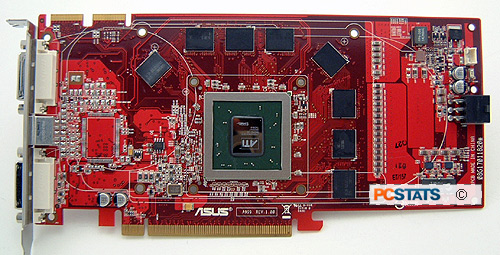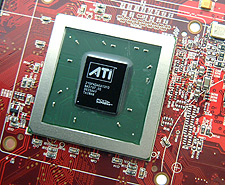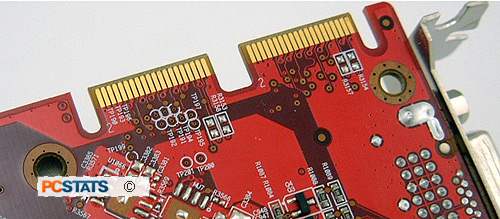The ATi Radeon X1950 Pro 'RV570' VPU supports 36 pixel shaders along with 8
vertex shaders. The memory uses a 256-bit 8 channel GDDR3 memory controller that
natively supports the PCI Express x16 bus. It's a DirectX 9.0C compatible GPU,
which means it supports all the latest games that employ Shader Model 3.0, Full
speed 32-bot floating processing, High Dynamic Range (HDR) rendering with
floating point blending and anti-aliasing, and high performance dynamic
branching and flow control. The less used OpenGL 2.0 standard is also fully
supported by the Radeon X1950 VPU. DirectX 10 is not supported, something to
keep in mind for when you eventually upgrade to Windows Vista.

The Radeon X1950Pro also supports your standard allotment of 2x, 4x and 6x Anti-aliasing modes,
which incorporate both sparse multi sample style rendering as well as temporal
anti-aliasing and adaptive anti-aliasing mode. There is lossless colour compression (up to
6:1) at all gaming resolutions, and the X1950 Pro can handle 2-16x anisotropic
filtering modes.
 ATi has made some well needed
changes to its AVIVO video engine, and it now supports dual independent displays; each of which
are capable of 30 bits per pixel. There is full symmetry
between both display heads, and each display offers resolutions beyond 2560x1600 pixels
for those of you with wide screen LCD displays. A component output (Y,
Pb, Pr) dongle allows the Radeon X1950 VPU to connect to
HDTV displays for a high bandwidth, high quality, viewing
experiences. The card is HDCP compliant.
ATi has made some well needed
changes to its AVIVO video engine, and it now supports dual independent displays; each of which
are capable of 30 bits per pixel. There is full symmetry
between both display heads, and each display offers resolutions beyond 2560x1600 pixels
for those of you with wide screen LCD displays. A component output (Y,
Pb, Pr) dongle allows the Radeon X1950 VPU to connect to
HDTV displays for a high bandwidth, high quality, viewing
experiences. The card is HDCP compliant.
There is seamless integration of pixel shaders with video for real live video
too. The 'RV570' VPU supports MPEG 1/2/4 encode/decode acceleration as well as
all DTV/HDTV decoding. Other video specific features include hardware motion
compensation, iDCT, DCT and Colour Space Conversion.
The ATi Radeon X1950 Pro normally operates with a core speed of 575 MHz and a memory
speed of 1.38 GHz. That's a bit lower than the Radeon X1950 XTX series which
runs at 650 MHz/1.55 GHz, and the Radeon X1950 CrossFire Edition (for the Radeon
X1950 XTX, the X1950 Pro does not require a CrossFire specific card) which runs
its core at 625 MHz and memory at 1.45 GHz. If you decided to overclock the Asus EAX1950PRO
to XTX levels, the videocard will not perform the same because ATi's flagship model
has 48 pixel shaders compared to the X1950 Pro's 36 pixel shaders.
Now,
lets take a closer look at what native Crossfire has to offer...
Native Crossfire on the X1950 Pro
ATi's first iteration of its dual
videocard technology, called CrossFire, had some severe limitations compared to
nvidia's method of implementation. First and foremost, Crossfire required the use of special
Master Radeon videocards which were often priced well above what the regular
models cost. Compound that with the limited availability of these Master cards and
the cumbersome cable set up and it was really no great surprise that ATI's
CrossFire took off like a lead duck.
 ATi addressed many of these with its Radeon X1950
Pro and all subsequent future Crossfire compliant
videocard generations. Instead of requiring a special
Master videocard, you can now simply match up any two cards
from the same product family. In our case, that would be twp Asus
EAX1950PRO videocards. Gone is the external cable connection, the new Native CrossFire now relies upon
a pair of Bridge Interconnect cards, similar in style to nVIDIA's SLI system.
ATi addressed many of these with its Radeon X1950
Pro and all subsequent future Crossfire compliant
videocard generations. Instead of requiring a special
Master videocard, you can now simply match up any two cards
from the same product family. In our case, that would be twp Asus
EAX1950PRO videocards. Gone is the external cable connection, the new Native CrossFire now relies upon
a pair of Bridge Interconnect cards, similar in style to nVIDIA's SLI system.
The Crossfire Bridge Interconnect system operates on a 24bit (2
x 12bit) connection, and supports speeds up to 350MHz. Thanks to the higher bandwidth
internal connection CrossFire support has been boosted to resolutions of 2560x2048. The first
version of CrossFire was limited to 1600x1200 because the older TMDS cable
connection would not support as much bandwidth.
There are two connectors on the Radeon X1950 Pro videocard and both are
suppose to be connected in order for native CrossFire to be enabled. No bridge
interconnect cards are included with the Asus EAX1950PRO/HTDP/256M/A package,
although the identical "Asus EAX1950PRO Crossfire/HTDP/256M" videocard does come
with two.
